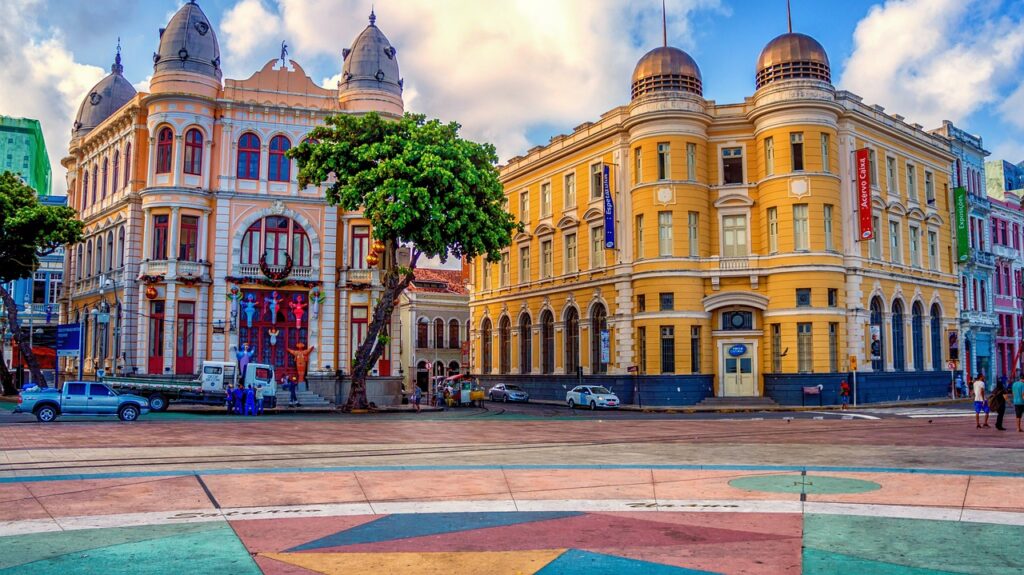I. Brazil’s Cultural Landmarks
Cultural landmarks in Brazil embody the nation’s rich history, diverse heritage, and vibrant creativity. These landmarks are not merely physical structures; they are living testaments to the stories, traditions, and innovations that have shaped Brazil’s identity over the centuries.
Brazil’s cultural heritage is a dynamic fusion of indigenous, African, European, and other influences. From the Amazon rainforest to the bustling urban centers, Brazil’s diversity is reflected in its art, music, literature, and religious practices. Exploring cultural landmarks allows one to delve into the multifaceted tapestry that is Brazil’s cultural heritage.
II. Indigenous Cultural Sites
Brazil is home to a rich tapestry of indigenous cultures, each with its unique traditions and customs. Indigenous communities contribute to the nation’s cultural mosaic, and visiting their sites provides a glimpse into their way of life.
Museums and cultural centers dedicated to indigenous heritage play a crucial role in preserving and showcasing the diverse cultures of Brazil’s native peoples. These institutions serve as educational hubs, fostering understanding and appreciation.
Preserving indigenous languages and traditions is essential for maintaining the cultural identity of Brazil’s native communities. Efforts to document, revitalize, and pass on these elements ensure the continuity of indigenous heritage for future generations.
III. Afro-Brazilian Cultural Heritage
A. The Influence of African Culture in Brazil
Brazil’s cultural landscape is profoundly shaped by the influence of African culture, which arrived with the forced migration of enslaved Africans during the colonial period. This rich heritage is visible in various aspects of Brazilian life, from art and religion to cuisine and language.
B. Candomblé and Other Afro-Brazilian Religions
Candomblé, a vibrant Afro-Brazilian religion, plays a central role in preserving and expressing African spiritual beliefs in Brazil. With roots in the Yoruba, Fon, and Bantu cultures, Candomblé ceremonies involve energetic music, dance, and rituals that honor deities known as “orixás.” This religious tradition, along with others like Umbanda, showcases the resilience and adaptability of African spiritual practices in the Brazilian context.
C. Celebrating Afro-Brazilian Culture Through Music and Dance
Afro-Brazilian culture finds dynamic expression in the realm of music and dance. From the rhythms of samba to the acrobatic movements of capoeira, Afro-Brazilian contributions are integral to Brazil’s cultural vibrancy. Festivals like Bahia’s Carnival highlight the Afro-Brazilian influence, providing a platform for celebration and expression of this rich cultural tapestry.
IV. Colonial and Imperial Landmarks
A. Portuguese Colonial Architecture and Its Legacy
Portuguese colonial architecture has left an indelible mark on Brazil’s urban and rural landscapes. Historic cities like Ouro Preto and Salvador showcase ornate churches, colonial homes, and cobblestone streets, transporting visitors to Brazil’s colonial past. These architectural gems stand as testaments to the fusion of European styles with local craftsmanship.
B. Historic Towns and Cities
Brazil boasts a wealth of historic towns and cities that capture the essence of its colonial and imperial history. Paraty, with its well-preserved colonial architecture, and Petrópolis, known for its imperial palaces, are living museums that offer a glimpse into Brazil’s transformative journey.
C. The Cultural Impact of the Brazilian Monarchy
The Brazilian monarchy, led by Emperor Pedro II, played a pivotal role in shaping the nation’s cultural identity. Palaces like the Imperial Palace in Rio de Janeiro and Petrópolis reflect the opulence of the monarchy. Despite its eventual dissolution, the cultural impact of the Brazilian monarchy endures in the nation’s traditions and historical consciousness.
V. Modern Cultural Movements
A. Brazilian Literature and Its Iconic Authors
Brazilian literature, deeply rooted in its cultural diversity, has produced iconic authors whose works transcend borders. From the existential narratives of Clarice Lispector to the social commentary of Machado de Assis, Brazilian literature captures the complexities of the nation’s identity and societal evolution.
B. Renowned Artists and Their Contributions to Modern Art
Brazil’s modern art scene boasts influential figures such as Tarsila do Amaral and Candido Portinari. Their works, inspired by both indigenous themes and modernist movements, have left an indelible mark on the global art landscape, showcasing Brazil’s unique artistic voice.
C. The Influence of Brazilian Cinema and Theater
Brazilian cinema and theater contribute significantly to the nation’s cultural discourse. The works of filmmakers like Glauber Rocha and the theatrical innovations of Augusto Boal exemplify Brazil’s commitment to storytelling as a means of cultural reflection and societal critique. Modern cultural movements continue to shape Brazil’s artistic landscape, bridging tradition and innovation.
VI. Cultural Festivals and Events
A. Carnival and its Cultural Significance
Carnival stands as one of the most iconic and culturally significant festivals in Brazil. Held annually, this vibrant celebration is a kaleidoscope of music, dance, and elaborate costumes. It transcends regional boundaries, with Rio de Janeiro’s samba parades, Salvador’s electric trios, and Olinda’s frevo dance contributing to the diverse tapestry of Carnival traditions.
B. Other Major Festivals and Celebrations
Beyond Carnival, Brazil hosts a myriad of festivals that celebrate its cultural diversity. Festas Juninas, dedicated to saints Anthony, John, and Peter, showcase traditional music, dance, and delicious treats. The Bumba Meu Boi festival in Maranhão, the Folia de Reis celebrations, and regional events like the Parintins Folklore Festival in the Amazon further enrich Brazil’s festive calendar.
C. The Role of Music and Dance in Brazilian Cultural Events
Music and dance are integral to Brazilian cultural events, embodying the spirit and energy of the nation. From the rhythmic beats of samba and forró to the intricate movements of capoeira, these art forms play a central role in expressing Brazil’s cultural identity. The diverse sounds and dances vary across regions, reflecting the country’s vast cultural mosaic.
VII. Religious and Spiritual Landmarks
A. Historic Churches, Cathedrals, and Religious Festivals
Brazil’s landscape is adorned with historic churches and cathedrals that narrate tales of faith and architectural brilliance. The Candelária Church in Rio de Janeiro, the São Francisco Church in Salvador, and the Sé Cathedral in São Paulo are just a few examples. Religious festivals, such as the Feast of Our Lady of Aparecida, highlight Brazil’s deep-rooted spiritual traditions.
B. Syncretism and Religious Diversity in Brazil
Syncretism is a distinctive feature of Brazilian religious life, blending African, indigenous, and European beliefs. Candomblé, Umbanda, and the rituals of the Maracatu in Pernambuco exemplify this syncretic fusion. The Festival of Yemanjá, honoring the Yoruba deity of the sea, showcases the coexistence of diverse religious practices in Brazil.
C. Pilgrimage Destinations and Spiritual Experiences
Brazil is home to pilgrimage destinations that draw believers seeking spiritual experiences. Aparecida, home to the National Shrine of Our Lady of Aparecida, attracts millions of pilgrims. The mystical town of Alto Paraíso in Goiás, known for its spiritual energy, offers a different kind of pilgrimage experience amidst natural beauty.
VIII. UNESCO World Heritage Cultural Sites
A. Brazil’s UNESCO-Recognized Cultural Treasures
Brazil takes pride in its UNESCO World Heritage Sites that embody the nation’s cultural and historical significance. The historic town of Ouro Preto, the modernist ensemble of Pampulha, and the colonial architecture of Olinda are among the recognized treasures. These sites stand as testaments to Brazil’s commitment to preserving its cultural heritage.
B. The Preservation of Historical and Artistic Significance
Preserving historical and artistic significance is paramount to UNESCO World Heritage Sites. The Brazilian government, in collaboration with international partners, invests in the conservation and restoration of these sites. The aim is not only to safeguard the physical structures but also to ensure that future generations can connect with Brazil’s rich cultural legacy.
C. Visiting and Exploring These Cultural Landmarks
For visitors, exploring Brazil’s UNESCO World Heritage Sites offers a journey through time and culture. Guided tours, educational programs, and initiatives promoting sustainable tourism enable travelers to engage with these landmarks responsibly. By appreciating and understanding the value of these sites, visitors contribute to their continued preservation.
IX. Architectural and Artistic Marvels
A. Iconic Buildings and Architectural Landmarks
Brazil boasts a wealth of iconic buildings and architectural landmarks that reflect its rich history and diverse cultural influences. The Cristo Redentor statue in Rio de Janeiro, designed by Heitor da Silva Costa, stands as an emblem of Brazilian art deco. Oscar Niemeyer’s modernist creations, including the National Congress in Brasília and the Museum of Contemporary Art in Niterói, showcase Brazil’s architectural innovation. Historic gems like the Amazon Theatre in Manaus and the São Francisco Church in João Pessoa are testaments to the country’s architectural legacy.
B. The Work of Renowned Brazilian Artists and Architects
Renowned artists and architects have left an indelible mark on Brazil’s cultural landscape. The works of architect Oscar Niemeyer, landscape architect Roberto Burle Marx, and modernist painter Tarsila do Amaral have gained international acclaim. The intricate woodwork of Aleijadinho, a master sculptor from the colonial period, and the contemporary brilliance of street artist Eduardo Kobra demonstrate the continuum of artistic excellence in Brazil.
C. The Historical and Artistic Significance of These Landmarks
Each architectural marvel and artistic creation in Brazil carries a unique historical and artistic significance. These landmarks serve as living chronicles, narrating stories of colonial conquests, indigenous resilience, and the modernist vision for a new Brazil. They contribute to a collective cultural memory, fostering a sense of identity and pride among Brazilians. Preservation efforts are vital to ensure that these treasures endure for future generations.
X. Museums and Cultural Institutions
A. Museums Showcasing Art, History, and Culture
Brazil is home to a diverse array of museums that showcase its multifaceted cultural heritage. The National Museum of Brazil in Rio de Janeiro, the Museum of Modern Art in São Paulo, and the Afro-Brazil Museum in Salvador house extensive collections. The Inhotim Institute in Minas Gerais stands out as a unique open-air museum, blending contemporary art with botanical gardens.
B. The Role of Cultural Institutions in Preserving Heritage
Cultural institutions play a pivotal role in preserving Brazil’s heritage by curating, conserving, and exhibiting artifacts and artworks. They serve as educational hubs, offering insights into the nation’s past, present, and future. Collaborative efforts between institutions, both within Brazil and internationally, contribute to the holistic preservation of cultural treasures.
C. The Significance of Preserving Brazil’s Cultural Legacy
Preserving Brazil’s cultural legacy is essential for fostering a sense of continuity and connection between generations. It allows for the exploration of diverse narratives, fostering understanding and appreciation for the complexities of Brazilian identity. Additionally, the preservation of cultural institutions ensures that Brazil’s artistic and historical achievements remain accessible to all, contributing to a shared cultural consciousness.
XI. Connecting with Brazil’s Cultural Heritage
Brazil’s cultural heritage is a tapestry woven with threads of indigenous traditions, colonial legacies, and modern expressions. Its diversity is a source of strength and resilience, offering a myriad of experiences for those who seek to explore its depths.
As readers embark on a journey through Brazil’s cultural landmarks, we encourage them to delve into the stories behind each monument, artwork, and institution. By appreciating the significance of these cultural treasures, travelers become not just spectators but active participants in the ongoing narrative of Brazil’s rich cultural heritage.
Let the exploration begin, and may the connection with Brazil’s cultural legacy be both enlightening and enriching.



